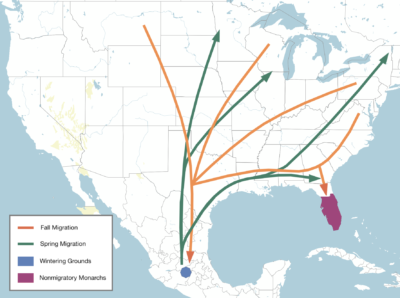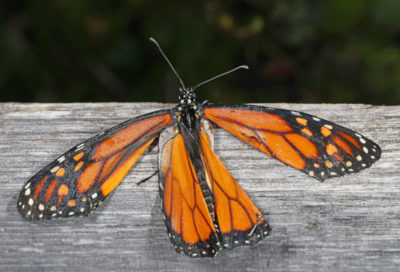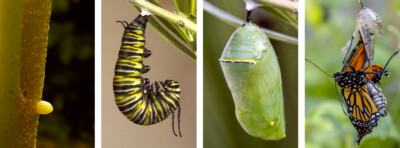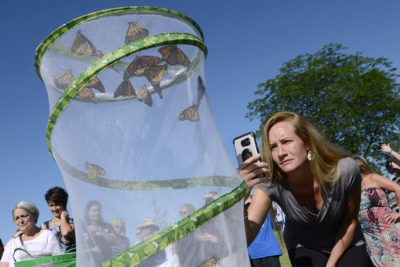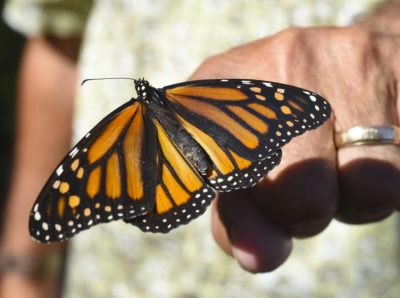To help the monarch butterfly, Texas writer Charlie Scudder decided to home-rear its caterpillars. Checking the milkweed in his garden one August evening he spotted two of the flamboyant black, white, and yellow-striped creatures. After naming them Pancho and Lefty after the Townes Van Zandt song, he moved them into a mesh butterfly cage. He checked on them several times a day, cleaning out their copious caterpillar poop, waiting with great anticipation to see them attach to the wall of the cage to form their chrysalises and eventually emerge as black and orange adult butterflies festooned with white spots.
But to Scudder’s dismay, one day Lefty began to shrivel. In a few hours, he was gone. Pancho was eaten by fire ants just before his transformation.
Convinced that the species is teetering on the brink of extinction, tens of thousands of monarch lovers have taken the butterfly’s fate into their own hands. Every year as summer wanes, monarchs east of the Rocky Mountains undertake a grueling, 3,000-mile migration, fluttering from their breeding grounds in the U.S. and Canada to their winter home on the rugged peaks of central Mexico’s Transvolcanic Belt. Since the 1990s, when the overwintering colonies began a steep decline that lasted 20 years, people have been rearing eggs and caterpillars in mesh enclosures on their porches and kitchen tables and releasing the adult butterflies.
“Everything we thought we knew about the monarch population is wrong,” says an influential butterfly researcher.
Aware that in the wild only 5 percent of monarch caterpillars reach adulthood, these home-rearers believe their efforts will boost the number of butterflies able to make it to Mexico. Many belong to Facebook groups that offer encouragement and often, when the caterpillars do not survive, condolences, with computer screens erupting in crying-face emojis.
But a handful of recent studies have rocked the small and disputatious world of monarch science, suggesting, in the words of University of Georgia ecologist Andy Davis, “that everything we thought we knew about the monarch population is wrong” and that the butterfly does not need our help. In fact, scientists say that home rearing and commercial breeding of monarchs — and the release of them at weddings, funerals, and other events — is one of biggest threats the butterfly now faces.
Two studies, in particular, have challenged the conventional wisdom about the monarchs. Publishing in Current Biology in September, researchers who sequenced the DNA of the butterfly’s primary host plant, common milkweed (Asclepias syriaca), and analyzed existing monarch DNA concluded that neither the monarchs nor the milkweed had suffered a catastrophic decline in the past 75 years. Their findings contradicted the widely held belief that the butterfly is imperiled due to the eradication of milkweeds by the spread of agriculture using the herbicide glyphosate and genetically modified crops, especially in the Midwest.
In a 2022 article in Global Change Biology, a statistical analysis of the North American Butterfly Association’s (NABA) massive database also found that the butterfly has suffered no sharp decline across its summer breeding range, as had been the prevailing view, and that the population there has actually increased by some 30 percent during the past 25 years. “There clearly are long-term declines in winter colony sizes,” says Davis, a coauthor of the study, but “they do not appear to be affecting the collective breeding population of [Eastern] monarchs.”
Monarch scientists are split into two camps, with one group continuing to maintain that the loss of milkweed is threatening the butterfly in its summer breeding grounds and therefore fewer butterflies are reaching Mexico. For this reason, they insist, the species must be protected under the U.S. Endangered Species Act.
The other camp, of which Davis is a leader, contends that it is problems encountered during the return trip to Mexico that have resulted in the diminished winter colonies, but not in the butterfly’s summer range in the U.S. and Canada, where the population has been able to bounce back. Pointing to the growing number of monarchs that now forego the migration and feed and breed year-round in Florida and across the Southeast coast, these scientists believe that the butterfly is in little danger of disappearing, though its epic migration is in peril.
The new science on the prevalence of the OE parasite has not dissuaded advocates from home-rearing monarchs.
“I do not think monarchs are currently threatened or an endangered species,” says Emory University biologist Jaap de Roode. Because the species is in no danger of becoming extinct, de Roode and others oppose listing it as an endangered species. And they believe that the fervor generated by constant assertions that the monarch is facing imminent extinction has spurred the public to engage in activities that are actually hastening the migration’s demise.
While researchers wrangle over this new research, there is universal agreement about the danger posed by the naturally occurring parasite Ophryocystis elektroscirrha (OE). A steady stream of studies has demonstrated that the parasite weakens the butterflies, making it less likely that they can complete the migration. The Xerces Society has published a joint statement signed by 10 top monarch biologists warning against the captive rearing and releasing of monarchs by backyard and commercial breeders. Such activities, they wrote, “promote crowding and disease spread.” “One thing Covid-19 taught us is that social distancing can help reduce the spread of infectious disease,” notes de Roode. “The same holds true for monarchs and the OE parasite.”
A monarch infected with the Ophryocystis elektroscirrha parasite.
Judy Gallagher via Flickr
De Roode is a coauthor of a third potentially game-changing study published in the Journal of Animal Ecology in 2022. It found that there has been a significant rise in OE prevalence since the early 2000s. The researchers attribute this spike to the increased density of monarchs in places where they lay their eggs, due in large part to the mass rearing of monarchs in confined spaces, and the widespread planting in recent years of non-native milkweeds, including the tropical milkweed (Asclepias curassavica) favored by monarch admirers. This surge in parasitism, they warn, may already be impairing the species’ migration: Their research indicates that in years when the summer OE infection rate was high, the winter colony size was unexpectedly low.
But the emerging science has not dissuaded monarch advocates from engaging in potentially damaging practices Donna Thompson — a hospice nurse who rears monarchs in part to donate to grieving families for release at memorial services and who launched a Facebook group, Donna’s Monarch Butterfly Sanctuary — says she does not believe much of the research. “I am grateful there are others who are willing to do what we can to help the monarchs before it is too late,” she posted in December. “Otherwise, those scientists will be scratching their heads one day saying, ‘I wish we had.’”
A recent study did not detect any decline of either common milkweed or Eastern monarchs in recent decades.
With a stout, straight stem that can reach 5 to 8 feet tall, thick, leathery leaves, and fist-size, pink-purple flower umbels, common milkweed is a standout in its native fields, croplands, and roadsides east of the Rocky Mountains. The plant is essential for successful monarch migration. It is also the focus of one of the fiercest disagreements in contemporary entomology.
In the recent Current Biology paper, researchers found that during the past 25,000 years every time the common milkweed population expanded, there was an increase in monarch abundance. For example, the numbers of both species swelled when European settlers, through deforestation and plowing of prairies, massively expanded the disturbed habitat that common milkweed prefers. But the scientists did not detect any decline of either common milkweed or monarchs in recent decades. According to their bombshell hypothesis, what they found “may be (at least in part) a return to pre-modern population sizes.” That said, they encouraged additional research “to test these ideas further.”
These results are consistent with the Global Change Biology study in which a team of statisticians and entomologists examined more than 135,000 monarch observations by NABA’s citizen scientists at 403 sites across the U.S and southern Canada between 1993 and 2018. Although they found that summer monarch abundance has dropped in some areas, such as parts of the Midwest, most likely due to the increased use of glyphosate, these losses have been offset by increases in other regions.
The life stages of a monarch (left to right), from egg to caterpillar to chrysalis to butterfly.
Sid Mosdell via Flickr; Sanka Vidanagama / NurPhoto via AP
The Eastern monarch’s northern migration spans four generations, and each female can lay about 400 eggs in her lifetime. For now, this astonishing fecundity appears to be compensating for any winter declines in Mexico. But the total loss of overwintering monarchs would make a summer rebound impossible. “This would leave only the year-round resident monarch populations” in Florida and other scattered areas in the South, they write, “with the loss of the epic migrations.” Fortunately, over the past decade the winter population in Mexico has stabilized, albeit at the lower level.
Karen Oberhauser, the recently retired director of the University of Wisconsin-Madison Arboretum, says the new studies do not influence her thinking. She is a leader of the group of scientists who hold that it is the loss of milkweed due primarily to herbicide-laced agriculture that is causing the monarch’s demise. “I don’t think the [NABA data] study tells us anything new. It shows, like other studies, that monarch numbers are declining in the Upper Midwest, the monarch’s most important breeding ground,” she says. What’s more, she says the persistent low numbers at the Mexican wintering sites suggest that decreases in the main breeding grounds are not being offset by increases in other regions. Oberhauser is also a prominent figure in the effort to list the monarch as endangered.
“We estimate that tens of millions fewer monarchs reach overwintering sites in Mexico as a result of OE,” one study says.
In September, the International Union for the Conservation of Nature (IUCN) downlisted the species from “endangered” to “vulnerable” after Davis petitioned the group, pointing out that according to IUCN criteria, the monarch is not in peril since the winter population in Mexico has shown no continued decline for the past 10 years. Last month, however, the monarch was listed under Canada’s Species at Risk Act, and the butterfly is expected to be listed under the U.S. Endangered Species Act this year.
There is no dispute about the threat from OE. The parasite forms microscopic, football-shaped spores that get sandwiched between the scales on monarch abdomens. When adult butterflies visit milkweed plants, they drop spores, which are ingested by the caterpillars. The resulting adults often have flimsy, misshapen wings and other defects, making it virtually impossible for them to complete the marathon migration.
“We estimate that tens of millions fewer monarchs reach overwintering sites in Mexico as a result of OE,” the authors of the Journal of Animal Ecology paper write — a formidable number, given that less than 100 million butterflies are making it to Mexico. As Davis, a coauthor of the study, notes, “We found absolutely no natural, ecological explanation for why [OE] prevalence increased so much.” It has been caused by humans, he concludes, pointing out that “the timing of the increase coincides with the rise in collective efforts to save the monarchs in the last 15 to 20 years, including mass-rearing of monarchs and planting of tropical milkweed.”
Monarchs just prior to release at the Marion VA Medical Center in Marion, Indiana in 2018.
Jeff Morehead / The Chronicle-Tribune via AP
Also known as scarlet milkweed or bloodflower, tropical milkweed bears eye-catching clusters of orange-red flowers with yellow “hoods.” Native to South and Central America, the plant is readily available at nurseries, providing monarch rearers with a constant supply of food for the voracious caterpillars.
Since 2015, numerous studies have implicated the soaring popularity of tropical milkweed in the OE epidemic. Because it remains leafed out and in flower much longer than native milkweeds, OE spores accumulate, increasing the risk of debilitating infection, especially in warm areas where the plants persist year-round.
Tropical and other non-native milkweeds are further imperiling the monarch migration, researchers say, by providing habitat that entices the butterflies to forego the journey and linger to feed and reproduce, forming so-called winter-breeding populations in the southern U.S. According to a paper published last year, since the 1960s winter-breeding colonies have been noted in Florida and across much of the Gulf Coast.
A 2021 California rule prohibits the public from removing monarchs from the wild or rearing them in captivity.
The extent to which these winter-breeding colonies are currently luring butterflies out of migration is still unknown, but the scientists say it is likely to increase as the number of these populations inevitably grows with climate change. And they add that because OE is rampant in these areas, it is unlikely that the winter-breeding populations would be able to become large and healthy enough to disperse throughout the species’ current summer breeding range, replacing the marathon journey to Mexico with a new, truncated migration route between the U.S. Southeast and southern Canada.
What, if anything can be done to curtail the activities of well-meaning, if misguided, monarch activists? Scientists and policymakers are currently grappling with this question.
Donna Thompson, for example, who still runs her Facebook group, says she followed the advice of scientists and tried growing only native milkweeds in her Maryland garden, “and it doesn’t work.” The non-natives she grows host hundreds of monarch eggs, she says, while the natives she planted support few to none. Every year she distributes thousands of the resulting plants free or at cost to members of the community. Thompson raised and released 800 caterpillars in 2022, and collectively her group released over 6,000.
A monarch butterfly is released at the Monarch Madness festival in Navarre, Florida in 2017.
Devon Ravine / Northwest Florida Daily News via AP
A growing number of researchers have ventured from the ivory tower to attempt to counter the morass of misinformation on social media. A year ago, Davis launched his own Facebook group, The Thoughtful Monarch, to spread the latest science. Davis has attracted a dedicated core of followers who repost his reports and musings on sites that promote home-rearing. He says it is too soon to tell if this effort is “working enough to really help the monarchs.”
Some scientists believe the answer is adoption of a federal version of the California Department of Fish and Wildlife’s 2021 “hands-off monarchs” rule. Designed to protect the small western monarch population, which breeds as far north as Washington state and overwinters along the California coast, it prohibits the public from removing from the wild or captively rearing monarchs.
In the meantime, an exasperated Davis offers his best suggestion: “Tell people that monarchs don’t need to be saved. They just need us to leave them alone.”
Correction, January 19, 2024: An earlier version of this article incorrectly stated the name of the organization providing data for a 2022 article in Global Change Biology. It is the North American Butterfly Association, not the National Butterfly Association.

